We visited Clava Cairns, a very well-preserved Bronze Age cemetery, in May 2015, at the time when broom is blooming everywhere in Scotland. No need to say how lovely the Scottish landscape can be then. After cloudy beginnings, the day had turned sunny and the sky was of the purest blue.
In the morning we had re-visited Brodie Castle and the magnificent Rodney Stone, a remarkable Pictish stone we had missed on our first visit in 2006. There, we also shared a delicious meal served in the NTS restaurant of this lovely pink castle which is one of our favourite ones.

Clava Cairns HES sign © 2015 Scotiana
Historic Environment Scotland (HES) is in charge of the site of Clava Cairns and one can find on the road its familiar brown signs which, like Tom Thumb’s white little pebbles, help us not to get lost on our way. 😉
Signposted from the B9091, the cairns of Balnaruan of Clava, best known as Clava Cairns, are one of Scotland’s most interesting prehistoric sites. They are situated in the Scottish Highlands, in a beautiful secluded wooded area, not far from the River Nairn, 6,7 miles east of Inverness and 1,5 miles from Culloden Battlefield, a quite different kind of cemetery! In the olden times the whole area was covered with prehistoric monuments but many of them have been destroyed in the name of agricultural progress. These megalithic monuments are dating back 4,000 years but archaelogical excavations show that the site had been used before for farming.
Once arrived on the site, the HES illustrated and detailed panels are very useful to try and immerse back into the lives of the ancient people of Scotland.

Clava Cairns © 2015 Scotiana
Spring is a wonderful season to travel in Scotland but happy are those who live in the area of Clava Cairns for it gives them the opportunity to visit the place at any time of the year, under the wonderful autumn colours, for example, or in winter, maybe with a little snow covering the cairns. Anyway, it would certainly be a good idea to choose the date of the winter solstice (December 21st or 22nd) to try and see the sunset down the line of the cairn entrance passages. The builders of these mysterious monuments had their own ideas about the sacred nature of the planets, especially of the sun, though nobody really knows today what they were. We can only guess…
As soon as we arrived at Clava Cairns we were overwhelmed by a feeling of awe and peacefulness, the big centenary trees and the old grey and mossy stones creating a most mysterious and strange atmosphere.
We did’nt know then that the site of Clava Cairns was composed of two separate sites. The one we visited, Balnauran of Clava, is the main site while Milton of Clava, a much smaller one, is situated in a field not far from the first one. Though it seems to be a very solitary and much less impressive place than Clava Cairns, it is certainly well worth the visit for lovers of history and prehistory for a standing stone, a cairn and the ruins of a medieval chapel are to be found there.
As can be seen very clearly on the above very interesting video, Balnauran of Clava is composed of three burial cairns, each one being surrounded by a stone circle. Two of them are ‘passage graves’ with the central burial chamber being accessed through a narrow corridor while the third one is only a ‘ring-cairn’.
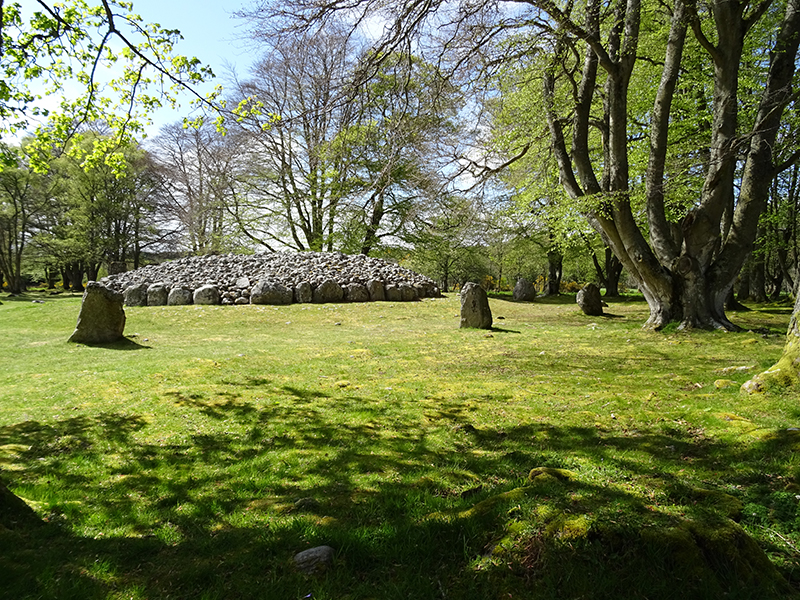
Clava Cairns South West Passage Grave © 2015 Scotiana
The three main cairns are surrounded by a circle of standing stones. Each cairn has an outer kerb and an inner chamber.

Clava Cairns grave’s entrance passage © 2015 Scotiana
The South West Passage and the North East Passage Grave have entrance passages, hence their names of “Passage Graves”.

Clava Cairns South-West Passage Grave HES panel © 2015 Scotiana
HS PANEL INFORMATION
The passage grave was built first and used for a short period before being deliberately closed and surrounded by a cobbled bank and stone circle. The chamber was excavated in 1828 but little is known of the human remains that were unearthed although the monument was certainly reused for a series of cremation burials dating from about 1000 BC. The line of the of the modern road has separated the southernmost stones of the circle and the cairn.
A common feature of these tombs is the use of decorated stones, carved with abstract designs.
The entrance to this chamber is marked by two tall slabs, one of which is carved with cup marks and cup and rings. There are more cup marks on the kerb. We can only guess at their significance. Were they carved specially to be incorporated into this tomb or were they taken from another structure?
This cairn shares the same alignment with the setting sun as the north-east passage grave.
Seen from this tomb, the midwinter sun would have set on the valley side, but, viewed from its counterpart, it would have seemed to rest on top of this cairn. Both Clava passage graves, made use of graded rings of stones which rose in height towards the axis of the midwinter sun.

Clava Cairns North East Passage Grave © 2015 Scotiana
Originally, the chambered cairns had roofs which means that the central chamber was enclosed.
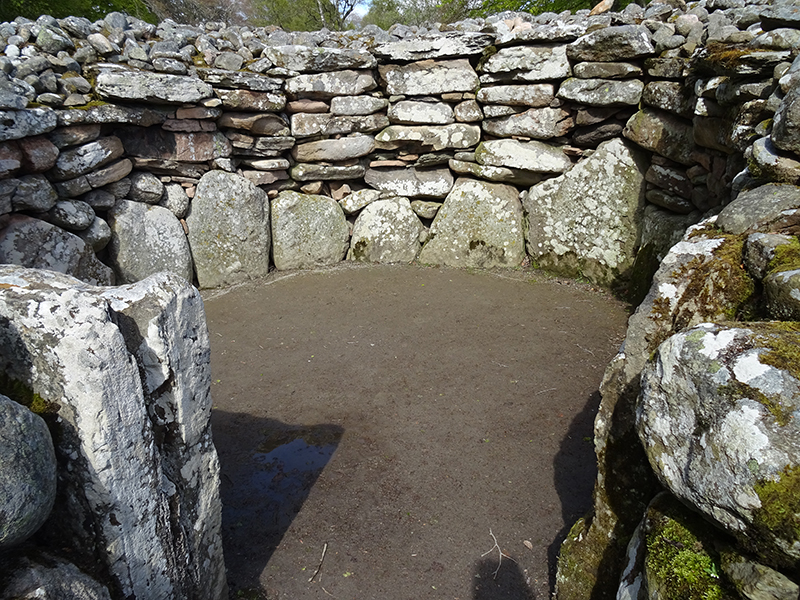
Clava Cairns grave chamber © 2015 Scotiana
Only one or two people were buried inside each cairn which, given the size of the graves, suggests that they were built for important people.
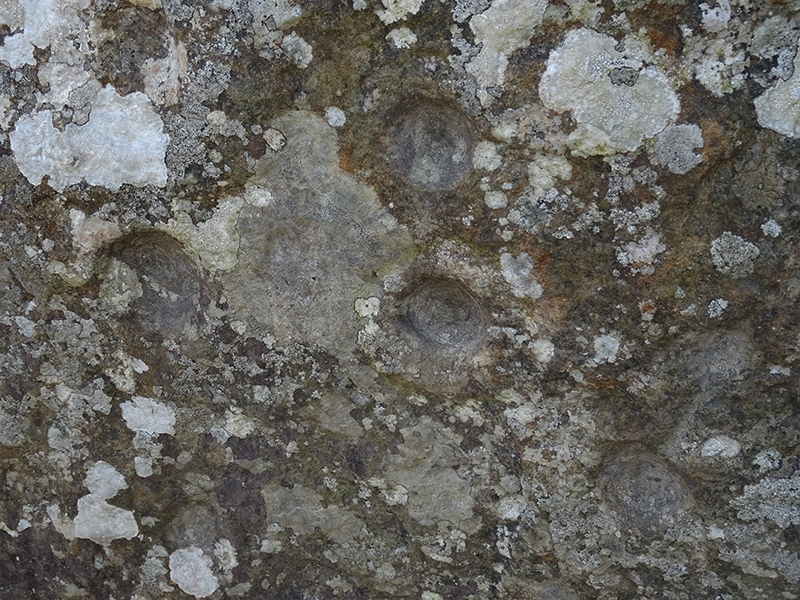
Clava Cairns cupmarks on the stones © 2015 Scotiana
One can notice several groups of cup and ring marks engraved into some of the stones but nobody really knows their significance…
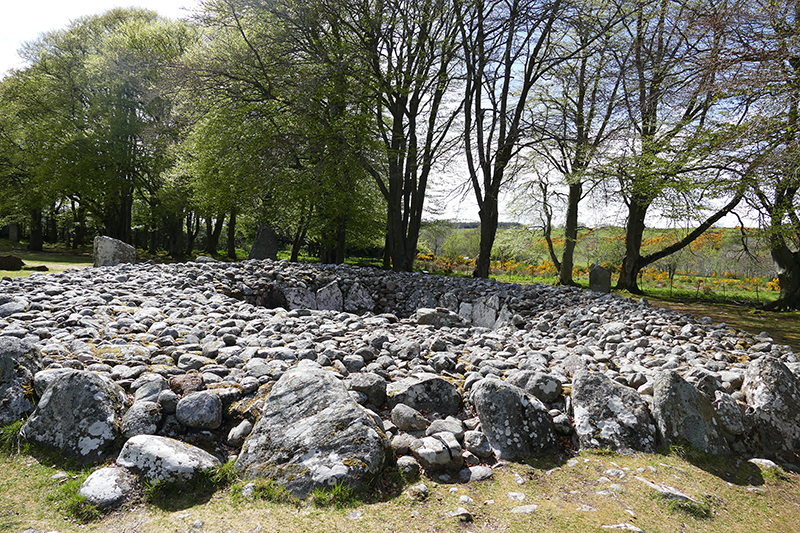
Clava Cairn Central Ring Cairn © 2015 Scotiana
The Central Ring Cairn has no entrance passage…
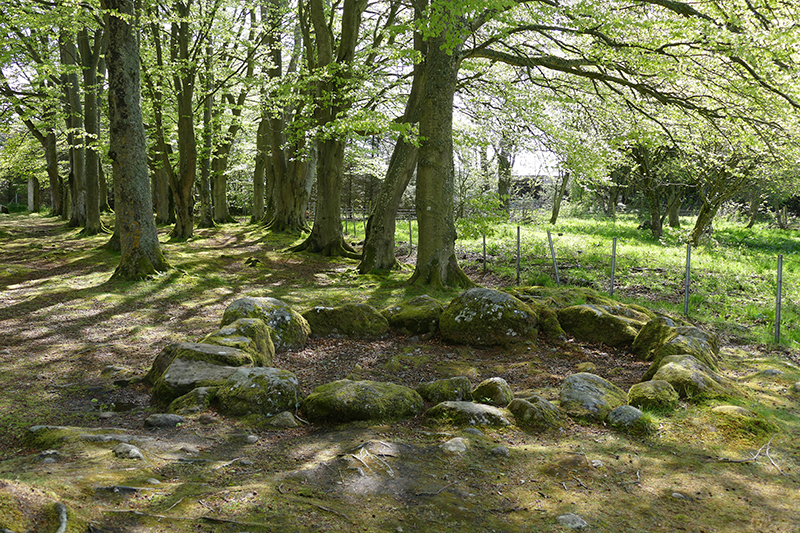
Clava Cairns Kerb Cairn © 2015 Scotiana
and there are also the remains of a kerb cairn.

Clava Cairns South West Entrance Passage Cairn © 2015 Scotiana
There is something magic about the place and we lingered quite a long time there.
We’ve always been captivated by megalithic monuments and we’ve seen many a number of them in Scotland: Callanish in the Hebrides, Skara Brae, the Ring of Brodgar, the Tomb of the Eagles, Maes Howe in Orkney…
If Dan Brown’s famous Da Vinci Code has attracted crowds of tourists to the Rosslyn Chapel, near Edinburgh, the site of Clava Cairns has been made famous by the publication of Diana Gabaldon’s Outlander. It has been suggested that Outlander’s fictitious stone circle, Craigh na Dun, was inspired by the site.
So far, I have not read any volume of Diana Gabaldon’s Outlander series but, now that I’ve visited the site of Clava Cairns, I can understand why it has inspired such kind of fantastic fiction.

The story begins :
In 1946, after working apart during the Second World War, British Army nurse Claire Randall and her husband Frank, a history professor, go on a second honeymoon to Inverness, Scotland. Frank conducts research into his family history and Claire goes plant-gathering near standing stones on the hill of Craigh na Dun. She faints when investigating a buzzing noise near the stones; upon waking, she encounters Frank’s ancestor, Captain Jack Randall (…)
Diana Gabaldon’s Outlander series Boxed Set of four novels :

Bonne lecture ! Á bientôt.
Mairiuna




Hi, I am asking if we can use the top picture of the road sign from Clava Cairns (Clava Cairns HES sign © 2015 Scotiana) for a book in Norwegian written by an archeologist named Kristin Prestvold. Credited of course as here.
Hi Maria! Please accept our sincere apologies for delay in getting back to you. Your request was overlooked from within the many requests we receive. It is with great pleasure that we give you permission to use our image with credit. Hope delay did not cause too much inconvenience. Until next, all the very best. Janice on behalf of Scotiana Team.